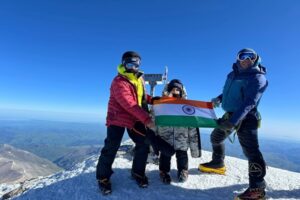The first climbers have finished their quarantine in Kathmandu and are ready to head off on their approach treks or to acclimatization peaks. All Europeans must quarantine for five to six days, then submit to a second PCR. If all is well, they can then move freely around the country.
Stefi Troguet had her test earlier today and flies to Lukla tomorrow. Troguet and climbing partner Jonatan García then start trekking up the Khumbu Valley to gain some altitude, then fly to Jomson to hike to their primary goal: Dhaulagiri.

One last COVID test for Stefi Troguet in Kathmandu before Dhaulagiri. Photo: Stefi Troguet
The Slovak-Romanian team bound for Dhaulagiri’s NW ridge are currently serving out their quarantine. Horia Colibasanu has been vaccinated but still had to quarantine.
Nomenclature and Vaccines
All members of the Bahraini Everest team were also vaccinated before flying to Nepal today, where they have begun serving their quarantine. Before heading to Everest, they will acclimatize on what they called the “Bahrain Royal Peaks…named after our beloved kingdom.”

Bahrain’s Everest team and their precious cargo of vaccines. Photo: Seven Summit Treks
Local Samagaon authorities approved the peaks’ rechristening after the Bahrain Royal Guards expedition climbed Manaslu last fall. They were the only ones to summit an 8,000m peak in Nepal in 2020. Shortly afterward, they were honored by “the renaming of a mountain in honor of HM King Hamad bin Isa Al Khalifa and HH Shk Nasser Bin Hamad Al Khalifa,” they initially declared.
That post spoke only of one 5,200m peak but this video refers to more than one of them. In return, the Bahraini team will donate 2,000 doses of Covid vaccine that they have brought in special containers.
Nepal started vaccinating in January, thanks to a donation from India of one million doses, plus a further 348,000 doses from the COVAX grants for low-income countries. The government bought an additional two million doses but is struggling to get more, so it is allowing private companies to import and sell them at a 10 percent profit, The Kathmandu Post reports. However, most of the population can’t afford to pay for shots.
Everest prep
Meanwhile, porters are toting supplies to base camps and climbers are already route-fixing. On Everest, in particular, expedition operators are busy laying in all kinds of supplies, from food and tents to hundreds of oxygen bottles. Tourism officer Mira Acharya estimates that 300 foreign climbers are expected on Everest, although other sources peg that estimate as high and suggest that 200 may be more realistic. In either case, it’s considerably less than the 381 registered in 2019 but still significant.
Besides local operators, some non-Nepali companies have also committed to going. In previous years, Lukas Furtenbach climbed mainly from the North Side but he has now moved his two teams to Nepal, the only side open to foreign climbers this season. Ryan Waters and Garrett Madison are also fielding Everest teams.
The largest outfitter is again Seven Summit Treks, which is servicing the Bahraini group on Everest, among others, plus other expeditions to all Nepal’s 8,000m peaks. Among their premier guides, Kami Rita Sherpa hopes to reach his 25th Everest summit this year.

Kami Rita Sherpa goes for his 25th Everest summit. Photo: Kami Rita Sherpa
Nepali Women for Annapurna
Meanwhile, Nepali women climbers Maya Sherpa, Poornima Shrestha, and Sharmila Syangtyan are heading for Annapurna. Maya Sherpa is the best-known female climber in Nepal with summits of K2, Everest, Kangchenjunga, Cho Oyu, Pumori, and Ama Dablam. Poornima Shrestha, a photojournalist, has already summited Everest, Manaslu, and Ama Dablam. Here’s hoping that they raise their funds and that we can follow their footprints on Annapurna.

Poornima Shrestha, ready for Annapurna. Photo: Poornima Shrestha





